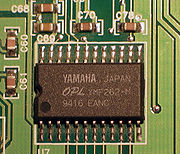
Yamaha YMF262
Encyclopedia

Frequency modulation synthesis
A 220 Hz carrier tone modulated by a 440 Hz modulating tone with various choices of modulation index, β. The time domain signals are illustrated above, and the corresponding spectra are shown below ....
sound chip
Sound chip
A sound chip is an integrated circuit designed to produce sound . It might be doing this through digital, analog or mixed-mode electronics...
. It is an improved version of the Yamaha YM3812
Yamaha YM3812
The Yamaha YM3812 also known as the OPL2 is a sound chip created by Yamaha Corporation in 1985 and famous for its wide use in IBM PC-based sound cards such as the AdLib and Sound Blaster.It is backwards compatible with the OPL aka YM3526, to which it is very similar – in fact, it only adds 3 new...
(OPL2), adding the following features:
- twice as many channels (18 instead of 9)
- simple stereo (hard left, center or hard right)
- 4 channel sound output
- 4 new waveforms (alternating-sine, "camel"-sine, square and logarithmic sawtooth)
- 4 oscillator mode, pairing 2 channels together to create up to six 4 oscillator FM voices
- reduced latencyLatency (engineering)Latency is a measure of time delay experienced in a system, the precise definition of which depends on the system and the time being measured. Latencies may have different meaning in different contexts.-Packet-switched networks:...
for host-register access (the OPL2 had much longer I/O access delays)
The YMF262 was used in many sound card
Sound card
A sound card is an internal computer expansion card that facilitates the input and output of audio signals to and from a computer under control of computer programs. The term sound card is also applied to external audio interfaces that use software to generate sound, as opposed to using hardware...
s, including the popular Sound Blaster Pro 2.0, Sound Blaster 16 ASP and AWE family.
Like its predecessor, the OPL3 outputs audio in digital-I/O form, requiring an external DAC
Digital-to-analog converter
In electronics, a digital-to-analog converter is a device that converts a digital code to an analog signal . An analog-to-digital converter performs the reverse operation...
chip like the YAC512. Competing sound chip vendors (such as ESS, OPTi) designed their own OPL3-compatible audiochips, with varying degrees of faithfulness to the original OPL3. Yamaha's later PC audio controllers, including the YMF278
Yamaha YMF278
The Yamaha YMF278B, also known as the OPL4 , is a sound chip that incorporates both sample-based synthesis and FM synthesis.-Sample-based synthesis component:...
(OPL4), the single-chip Yamaha YMF718/719S, and the PCI YMF724/74x family, included the YMF262's FM synthesis block for backward compatibility with legacy software. See YMF7xx for more information.
External links
- MIDIbox FM, a YMF262-based DIY synthesizer
- AdlibTracker.net Adlib Tracker II (YMF262-Tracker)
- An YMF262 emulator with an online player for OPL3 music.
- OPLx decapsulated (a reverse engineering report)

